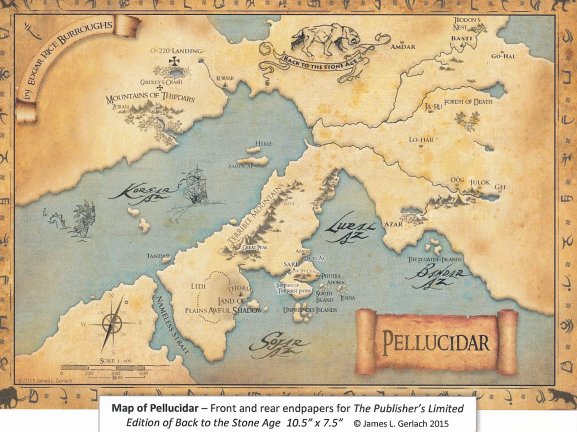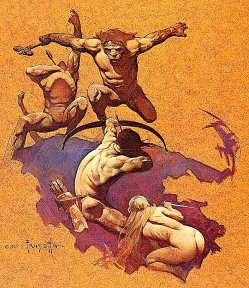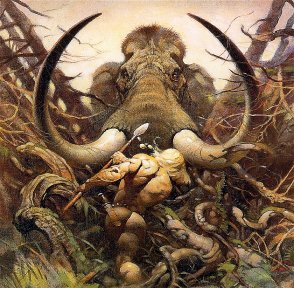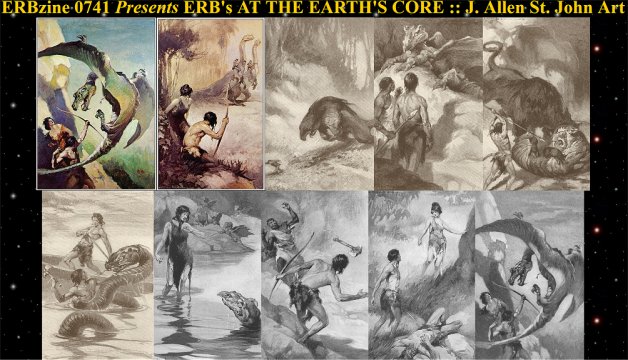
Presuppositions About Pellucidar
By John Martin


The Homing Instinct
 David Innes, in the first two Pellucidar books, spoke authoritatively
on many subjects about the Inner World.
David Innes, in the first two Pellucidar books, spoke authoritatively
on many subjects about the Inner World.
But by the time he communicated with Jason Gridley
to narrate the sixth book, "Land of Terror," he had to admit that he had
not always known what he was talking about.
In Chapter 19 of "Land of Terror," for example,
he says, "I assumed, for instance, that those things which came within
the range of my experience were typical of all Pellucidar. I assumed, for
instance, that the Mahars...were dominant throughout the entire area of
Pellucidar; but now I realize that I do not know this, for the land area
of Pellucidar is enormous, and I had seen only a very tiny portion of it.
"Likewise my assertion that three-quarter of the
surface of Pellucidar is land, giving a total land area considerably greater
than that of the outer crust, was based solely upon Perry's theory that
depressions upon the outer crust were protuberances upon the inner crust;
so that the land areas in Pellucidar corresponded roughly with the oceans
of the outer world; but of course that is only a theory, and I do not know
that it is true."
However, Perry's ideas were based on more than
a theory. He was actually looking at a Mahar map (Earth's Core, 5) when
he was talking to David about the area of the inner world. It's possible
that he may not have understood the map properly, being new to Pellucidar.
But it is true, as David admitted, that there are
many statements, ideas or concepts put forth in the earlier Pellucidar
books which just couldn't stand the test of "time." And although the last
two Pellucidar books have sometimes been referred to as literary midgets,
as potboilers, we can be thankful to those two volumes, and to passages
in some of the mid-series books, for straightening us out on a few things
about Pellucidar.
Some of these things (and there may be others)
are the Pellucidarian homing instinct, bows and arrows, domestic animals,
money, language and fire.
One of the most fascinating aspects of life in
Pellucidar is the homing instinct, possessed by every native Pellucidarian.
On the outer surface even a man without instruments can figure out how
to find his way by observing the movements of the sun and stars. But in
Pellucidar, with a stationary sun and no stars, Perry wondered how the
dwellers knew where they were going. Ghak the Hairy One replied that any
Pellucidarian, blindfolded and carried to a far land, could find his way
home again unerringly by the shortest route. Perry dubbed it a "homing
instinct," similar to that possessed by certain pigeons and even some animals
of the outer surface. (Earth's Core, 5)
In subsequent books, we are given more information
on the characteristics of this instinct: "Mountains, river, and seas may
have to be gone around, but never once does his sense of direction fail
him--the homing instinct is supreme. In the same remarkable way, they never
forget the location of any place to which they have ever been, and know
that of many of which they have only heard from others who have visited
them. In short, each Pellucidarian is a walking geography of his own district
and of much of the country contiguous thereto." (Pellucidar, 4)
In "Tanar of Pellucidar," we find that the homing
instinct is also a homing "urge." Stranded on the island of Amiocap, we
read of Tanar in Chapter 3, "To this primitive mountaineer it seemed little
short of hopeless even to dream of returning to his native land, for the
sea appalled him, nor did he have any conception as to how he might set
a course across its savage bosom, or navigate any craft that he might later
find at his disposal; yet so powerful is the homing instinct in the Pellucidarians
that there was no doubt in his mind that so long as he lived he would always
be searching for a way back to Sari."
In TP 15, ERB tells how Pellucidarians use their
fingers as a sort of direction finder to help point the way to places other
than their own home. Using the method he describes, "...A Sarian pointing
in the direction of The Land of Awful Shadow would say that he was traveling
two left fingers from Sari, since the middle finger of the left hand would
be pointing about due south toward The Land of Awful Shadow."
In both "Tarzan at the Earth's Core" (Chapter 6)
and "Back to the Stone Age" (Chapter 4) we learn that the homing instinct
is possessed by all animals of Pellucidar, as well as by humans.
Now all of this is "progressive revelation," as
each book adds to our store of knowledge. But in the last two books, the
knowledge gets downright contradictory! For in the earlier books we are
told that the homing instinct does not work if the Pellucidarian is at
sea, but only if he is on dry land. In the last two books, the instinct
works everywhere!
David Innes becomes aware of this "water hazard"
in "Pellucidar," Chapter 12, when he, Dian and Jaug are attempting to return
to the mainland by boat. David suggests that they steer simply by allowing
Dian, with her homing instinct, to point the way to Amoz. Sadly, Dian replies,"We
could do all this upon land. But upon the water that power is denied us.
I do not know why; but I have always heard that this is true--that only
upon the water may a Pellucidarian be lost. This is, I think, why we all
fear the great ocean so -- even those who go upon its surface in canoes.
Jaug has told us that they never go beyond the sight of land."
In "Tanar," Chapter 4, we read something similar:
"Tanar moved always in one direction and his homing instinct assured him
that the direction lay toward Sari. As far as land went he could move unerringly
toward the spot in Pellucidar where he was born. Every Pellucidarian can
do that, but put them on the water, out of sight of land, and that instinct
leaves them and they have no more conception of direction than would you
or I if we were transported suddenly to a land where there are no points
of compass, since the sun hangs perpetually at zenith and there is no moon
and no stars."
Since there is a Pellucidarian moon, however, Tanar
was probably referring to those instances where someone was on the far
side of the sun and could not ascertain where the moon was, due to it being
obscured either by the sun itself or by the brightness thereof.
But when we come to "Land of Terror," it's necessary
to throw out all that previous conventional wisdom on the homing instinct
and water.
First, we have U-Val, a resident of The Floating
Islands. Even though the islands move about, U-Val says of his particular
island. "I will always know where Ruva lies, no matter where it is. I do
not know how. I simply know." (LT, 21)
In the last chapter of LT, we find out that Lu-Bra
and Dian the Beautiful, on separate ocean journeys, are both able to find
their way back home by the aid of the homing instinct.
In "Savage Pellucidar" (I:11) the Mezops are using
their homing instinct instead of Perry's rustic navigational aids, and
in II:4, a man of Amoz (Dian's home tribe) is the compass at sea.
The easy way out of this would be simply to say
that ERB forgot what he had written earlier. After all, several years had
elapsed since he had last written of Pellucidar.
But other explanations are possible. Here are three:
1. Since ERB promotes various theories
of evolution in this and other series, we could just say that evolution
speeded up for awhile and that the homing instinct "evolved" to enable
the Pellucidarians to use it upon the sea.
2. We could say that the homing instinct is really
a skill, and that, as the advent of David's empire brought about more sea
travel, they learned how to make their instinct work at sea.
3. My favorite solution to the problem: They had
the ability all along, but just didn't realize it! After all, they were
superstitious to a degree. They believed that Pellucidar floated upon a
sea of fire. They were afraid of going out too far onto the ocean for fear
of falling off the edge. Could not this fear have fostered the notion that
their homing instinct would fail them upon the sea? In the boat with Jaug
and David in "Pellucidar," Dian apparently doesn't even try to exercise
her instinct; she just says she has heard it isn't possible. Also, most
Pellucidarians didn't have much experience at sea, so they wouldn't have
had much opportunity to prove the theory one way or the other. "Tanar of
Pellucidar" is narrated by Abner Perry, so the mention there of the homing
instinct's failure on water may simply be him repeating what he has been
led to believe.
2. Bows and Arrows
 While prisoners of the Mahars, "Perry conceived the idea of making bows
and arrows, weapons apparently unknown in Pellucidar." (At the Earth's
Core, 5).
While prisoners of the Mahars, "Perry conceived the idea of making bows
and arrows, weapons apparently unknown in Pellucidar." (At the Earth's
Core, 5).
This proved a very popular new weapon in the Empire
of Pellucidar where it was, apparently, not known. David refined this weapon
by making poison arrows when he came across a nest of vipers in "The Garden
of Eden." (Earth's Core, 14). Much later, David ingratiated himself with
the tribe of Ruva by tying a cord to his arrows and shooting fish for the
people (Land of Terror, 23).
But beyond the Sari-based empire, we learn in Savage
Pellucidar, there are other peoples who have fashioned bows and arrows
without David's help. These are the men of Lolo-Lolo and Tanga-Tanga, the
men who have advanced beyond "cave man" stage to the bronze age. (SP-II:4)
Another previously unheard of tribe which uses
the bow and arrow is the tribe of Zurk the Zurt, who tries to use the weapon
to shoot O-aa's jalok (Savage Pellucidar, IV:9), but whether these tribesmen
developed the weapon on their own or whether they got the idea from another
tribe, which may have in turn gotten it from the empire, we aren't told.
3. Domestic Animals
 In Pellucidar, chapter 7, David saves a hyaenodon from drowning and it
becomes his friend. "I had a dog!" David exclaimed. "I had never guessed
precisely what it was that was lacking in life in Pellucidar, but now I
knew that it was the total absence of domestic animals. Man here had not
yet reached the point where he might take the time from slaughter and escaping
slaughter to make friends with any of the brute creation."
In Pellucidar, chapter 7, David saves a hyaenodon from drowning and it
becomes his friend. "I had a dog!" David exclaimed. "I had never guessed
precisely what it was that was lacking in life in Pellucidar, but now I
knew that it was the total absence of domestic animals. Man here had not
yet reached the point where he might take the time from slaughter and escaping
slaughter to make friends with any of the brute creation."
So there, David made another assumption. This time,
immediately, he began to clarify it, for in the very next sentence, as
if suddenly remembering something, he says, "I must qualify this statement
a trifle and say that this was true of those tribes with which I was most
familiar. The Thurians do domesticate the colossal lidi, traversing the
great Lidi Plains upon the backs of these grotesque and stupendous monsters,
and possibly there may also be other, far-distant peoples within this great
world, who have tamed others of the wild things of jungle, plain or mountain.
While it is a bit of a stretch to refer to Horibs
as people, these repulsive creations from "Tarzan at the Earth's Core,"
do, at least, have an intelligence capable of domesticating another species.
Their mounts are the Gorobors, swift, giant lizard-like creatures.
"Back to the Stone Age" gives us the Mammoth Men,
a tribe which captures and trains the fierce, tusked creatures as riding
mounts. Von Horst, the hero of the book, acquires a mammoth himself, though
through no special skill. He simply rescues the animal from a trap and
it follows him around for awhile like an oversize dog and proves a good
creature to have on your side in danger-fraught Pellucidar.
In "Savage Pellucidar" are two groups of people
who domesticate animals.
On the island of Tandar is a tribe which has tame
tarags (saber-toothed tigers) hanging around. Dian the Beautiful, a temporary
prisoner, befriends some of these animals by sneaking them extra pieces
of meat. When she escapes, the tarags assist her, setting the stage for
a great Frazetta image! A rival tribe on the island trains the taho, a
prehistoric lion (SP III)
Also in Savage Pellucidar, O-aa makes friends with
a jalok (IV-4) which turns out to have been domesticated by the Zurt tribe
(IV-6)
4. The Allure
of Money
David Innes and Abner Perry assumed money was
unknown in Pellucidar and, in a noble effort, they were determined that
it would stay that way. In "Pellucidar," Chapter 15, we read: "There is
no money, nor is any money value placed upon any commodity. Perry and I
were as one in resolving that the root of all evil should not be introduced
into Pellucidar while we lived." He went on to explain the Pellucidar system
of trade.
Our two heroes get an "A" for effort, but the money
part of civilization had, alas, already infiltrated into the inner world,
a fact they were to learn later.
Taken as captives by the Korsars and ordered to
build them better weapons, David and Ja were, instead, trying to figure
out a way to escape. In "Tanar of Pellucidar," Chapter 14, it says, "By
the order of The Cid, Fitt had furnished his three prisoners with ample
funds in the money of Korsar that they might make necessary purchases in
the prosecution of their investigation and their experiments.
"The money, which consisted of gold coins of various
sizes and weights, was crudely stamped upon one side with what purported
to be a likeness of The Cid, and upon the other with a Korsar ship. For
so long a time had gold coin been the medium of exchange in Korsar and
the surrounding country that it was accepted by the natives of even remote
villages and tribes, so that David had little difficulty in engaging the
services of eight carriers and their two hampers to carry equipment...."
So it wasn't simply a matter that the Korsars,
who had moved from the outer world to the inner to settle, had brought
along the concept of money, but it was taking hold with some of the primitive
tribes of Pellucidar as well.
In "Savage Pellucidar," we find money has found
its way into the economy of the Bronze Age men, who not only have developed
an eight-sided coin, but have invented a religion as well, since so often
the love of money and false religion seems to go together. (Savage Pellucidar,
II:5)
5. Languages
Thus far, Iíve mentioned conclusions made in early
books that were proven wrong later. But in this case, we have a statement
in a later book that was proven wrong earlier!
In the sixth volume of the seven-book series, "Land
of Terror," Chapter 2, David says of his captors: "I could easily understand
them, as they spoke the language that is common to all human beings in
Pellucidar, insofar as I know, for I have never heard another. Why all
races and tribes, no matter how far separated, speak this one language,
I do not know. It has always been a mystery to both Perry and myself. Perry
suggests that it may be a basic, primitive language that people living
in the same environment with identical problems and surroundings would
naturally develop to express their thoughts. Perhaps he is right -- I do
not know; but it is as good an explanation as any."
In the above passage, David may be speaking of
strictly human language. We know that Sagoths speak a pidgin form of the
Pellucidarian language and also speak the language of the great apes, among
whom Tarzan grew up on the outer surface. There are also sabertooth men
who are not fully human who speak a language all their own (Savage Pellucidar,
I:47)
But David was forgetful when he claimed to have
never heard another human language. When he first encountered Ja the Mezop
as he attempted to steal Ja's canoe, he ended up saving Ja from a denizen
of the deep. This turn of events was to form a friendship that was to last
from then on, but the hurdle of language had to be overcome first.
In "At the Earth's Core," Chapter 8, David says
of Ja, "Presently he spoke to me, but in a tongue which I was unable to
translate." David then tried the pidgin tongue of the Sagoths and Ja understood
that, so they conversed.
But Ja did not understand the language of the men
of Sari and Amoz, which was the first language David would have tried.
Why these Mezops, who lived so close to these two cities, would not have
gotten some familiarity with it over the years, is a mystery.
Since Ja and the Mezop tribes were to become the
naval arm of David's empire, they must have had to do a lot of studying
to pick up on the language that everybody else in Pellucidar spoke.
Their situation might be compared with that of
natives in the Americas, who have their own tribal dialects but who today
all mainly speak English as their everyday language.
Another curiosity, language-wise, is that the Korsars,
who came from the outer crust, apparently adopted native Pellucidarian
as their official language at some point. No communication problems seemed
to exist between Korsars and their legions of enemies. Most groups tend
to proudly and tightly hang onto their native language as a part of their
heritage and culture, but obviously, in Pellucidar, whole groups made exceptions
to that tradition just to be better understood by their friends and their
enemies.
6. Flames of the Inner
World
David Innes never makes the assumption that fire
is unknown to Pellucidarians, but he does make note that during his early
adventures there is no fire to be found.
And perhaps the reader is the one who might make
the assumption that fire is yet unknown to these people, and that David
will have to be their Prometheus along with all the other hats he is wearing.
Such is not the case, however. Fire is well-known
and widely used on Pellucidar. It's just that we have to get a ways into
the series before we find this out.
After arriving in Pellucidar and being taken prisoner,
David and Abner are led into the Mahar cavern, and David notes: "We had
seen no artificial light or sign of fire since we had entered Pellucidar...I
marveled that they had no means of lighting their way through these dark,
subterranean passages." (At the Earth's Core, 4)
In AEC-14, we find David, on his own, still without
fire in Pellucidar as he has a "meal of raw meat, to which I had now become
quite accustomed."
Finally, in the last chapter of AEC, we learn that
fire must have been available, because Perry fails "to produce a gunpowder
that would even burn."
One thing David made sure of when he went back
to the outer crust was to bring back some dry matches. In "Pellucidar,"
Chapter 1, David says, "I also strapped a considerable quantity of ammunition
across my shoulders, pocketed some matches, and hooked an aluminum frypan
and a small stew-kettle of the same metal to my belt."
In Chapter 3, Perry builds a fire, then used an
ember to touch off some experimental gunpowder. The "gunpowder" extinguished
the ember!
But if we are still thinking that the only fire
in Pellucidar comes when David or Abner are present, that notion is put
to rest in the following books when the floodgates of fire open and we
find out that everybody has had it all along. There are many examples,
but here are just a few:
-
Amiocapans plan to burn Tanar and Stellara at the stake (Tanar
of Pellucidar, 4)
-
Tanar makes fire by the primitive method of rapidly revolving
a sharpened stick in a tinder-filled hole in a large piece of dry wood.
(TP, 5)
-
Thoar makes fire by the primitive expedient of friction.
(Tarzan at the Earth's Core, 6)
-
La-Ja has firestones (Back to the Stone Age, 9) and uses
it to make torches.
-
The Bison Men use fire, but their slaves build it for them
(BSA, 20).
-
Women warriors of Oog do what David had never seen before
or since in Pellucidar. "They lighted torches, made of what I afterward
learned to be a resinous reed, and hurled them among us. These torches
gave off volumes of acrid black smoke that blinded and choked us." (Land
of Terror, 2)
-
O-aa makes fire, but we're not told how. (Savage Pellucidar,
IV:6)
So David didn't have to spend time teaching people
how to start fires; but he did have to put a few out.



![]()
![]()
![]()

![]()